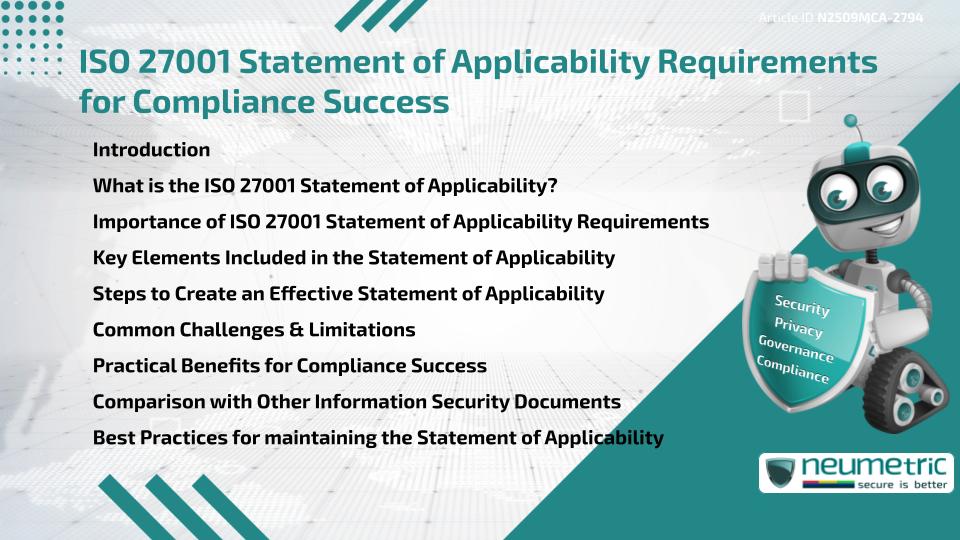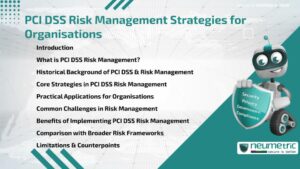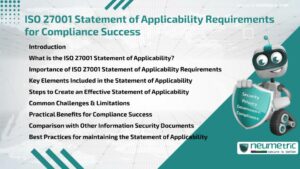Table of Contents
ToggleIntroduction
The ISO 27001 Statement of Applicability requirements form one of the most crucial components of an Information Security Management System [ISMS]. This document acts as both a Roadmap & a proof of Compliance by mapping chosen Security Controls against business Risks. It defines which Controls from ISO 27001 Annex A are implemented, which are excluded & the justification behind these decisions. A well-prepared Statement of Applicability [SoA] ensures Transparency, Accountability & Compliance with Audit expectations. Without it, organisations Risk failing Audits & weakening their Information Security Framework.
What is the ISO 27001 Statement of Applicability?
The Statement of Applicability is a mandatory document under ISO 27001. It lists all Security Controls from Annex A, specifies whether each control is applicable & provides a rationale. If implemented, it describes how the control is applied; if excluded, it justifies why it is not needed. Think of it as a checklist that tells Auditors & Stakeholders exactly what protections are in place & why.
Importance of ISO 27001 Statement of Applicability Requirements
The ISO 27001 Statement of Applicability requirements ensures consistency in documenting Security Practices. It shows that an organisation has not only identified its Risks but also aligned them with appropriate controls. It acts as a bridge between the Risk Assessment & the actual Control Implementation. This is especially important for demonstrating Compliance during external Certification Audits.
Key Elements Included in the Statement of Applicability
An effective SoA generally includes:
- A complete list of Annex A controls
- A decision on whether each control is applied or not
- Justifications for exclusions
- Descriptions of implemented controls
- References to relevant Policies or Procedures
By including these elements, the SoA becomes more than a formality-it becomes a practical management tool.
Steps to Create an Effective Statement of Applicability
Creating the SoA involves several steps:
- Conduct a Risk Assessment to identify Threats & Vulnerabilities.
- Map Risks to relevant Annex A controls.
- Decide which Controls to implement or exclude.
- Document each decision with clear justification.
- Link the SoA to supporting Procedures & Policies.
- Review & Update regularly to reflect changing Risks.
This process ensures the SoA remains aligned with Business priorities & Compliance goals.
Common Challenges & Limitations
Organisations often face difficulties when preparing the SoA. Common issues include:
- Overlooking the need for detailed justifications for excluded controls.
- Treating the document as a one-time exercise rather than a living record.
- Misalignment between the SoA & Risk Assessment results.
- Lack of Stakeholder involvement in defining applicability.
These challenges can reduce the credibility of the SoA & hinder Compliance.
Practical Benefits for Compliance Success
When correctly implemented, the SoA delivers several benefits:
- Provides Auditors with a clear Compliance Roadmap.
- Enhances organisational understanding of security responsibilities.
- Demonstrates Accountability to Clients & Partners.
- Helps prioritise resources by focusing only on relevant controls.
In practice, a strong SoA saves time during Audits, improves Trust with Stakeholders & strengthens the overall ISMS.
Comparison with Other Information Security Documents
Unlike the Risk Assessment or Risk treatment plan, the SoA directly maps controls to Compliance Requirements. While a Risk Assessment identifies Threats, the SoA translates those Risks into actionable Security Measures. Compared to Policies, it is less about intentions & more about documented Evidence.
Best Practices for maintaining the Statement of Applicability
To ensure long-term value, Organisations should:
- Update the SoA after every major Risk Assessment.
- Keep documentation clear & consistent.
- Involve Stakeholders from across departments.
- Use the SoA as a tool for regular Internal Audits.
By treating the SoA as a dynamic document, Organisations can adapt quickly to new Risks without compromising Compliance.
Conclusion
The ISO 27001 Statement of Applicability requirements are not simply a Certification hurdle. They provide structure & visibility into how an organisation secures its information assets. With careful preparation & consistent updates, the SoA can serve as both a Compliance asset & a practical tool for ongoing Information Security Management.
Takeaways
- The SoA is a mandatory ISO 27001 document.
- It maps Annex A controls to organisational Risks.
- Exclusions must be fully justified.
- Regular updates are critical for accuracy.
- A well-maintained SoA simplifies Audits & boosts Trust.
FAQ
What is the purpose of the ISO 27001 Statement of Applicability?
It documents which Annex A controls are implemented, excluded & why, providing clarity for Audits & Compliance.
How often should the Statement of Applicability be updated?
It should be updated after Risk Assessments, Audits or whenever significant changes to Risks or Controls occur.
Is the Statement of Applicability mandatory for ISO 27001 Certification?
Yes, it is a compulsory document & without it, certification cannot be achieved.
What happens if a control is excluded from the Statement of Applicability?
The exclusion must be justified with a clear explanation of why the control is not relevant.
How does the Statement of Applicability differ from a Risk Assessment?
A Risk Assessment identifies Threats, while the SoA maps selected Controls to address those Risks.
Who is responsible for preparing the Statement of Applicability?
Typically, the ISMS manager leads the process with input from relevant Stakeholders.
Can templates be used to prepare the Statement of Applicability?
Yes, templates can be helpful but they should be tailored to the organisation’s specific Risks & environment.
Need help for Security, Privacy, Governance & VAPT?
Neumetric provides organisations the necessary help to achieve their Cybersecurity, Compliance, Governance, Privacy, Certifications & Pentesting needs.
Organisations & Businesses, specifically those which provide SaaS & AI Solutions in the Fintech, BFSI & other regulated sectors, usually need a Cybersecurity Partner for meeting & maintaining the ongoing Security & Privacy needs & requirements of their Enterprise Clients & Privacy conscious Customers.
SOC 2, ISO 27001, ISO 42001, NIST, HIPAA, HECVAT, EU GDPR are some of the Frameworks that are served by Fusion – a SaaS, multimodular, multitenant, centralised, automated, Cybersecurity & Compliance Management system.
Neumetric also provides Expert Services for technical security which covers VAPT for Web Applications, APIs, iOS & Android Mobile Apps, Security Testing for AWS & other Cloud Environments & Cloud Infrastructure & other similar scopes.
Reach out to us by Email or filling out the Contact Form…





